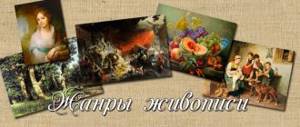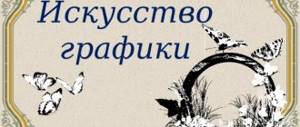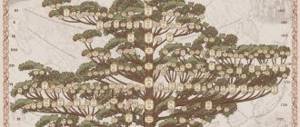Author's position: art teacher
Animalistic genre in painting
Animalistic genre
(from Latin animal-animal) - the image of animals in painting, sculpture and graphics, which combines natural science and artistic principles and develops observation and love for nature. The animal artist pays main attention to the artistic and figurative characteristics of the animal, its habits, its habitat (for example, in easel painting and sculpture, in printmaking): the decorative expressiveness of the figure, silhouette, and colors is especially significant in park sculpture, paintings, and small plastic works; Often (especially in illustrations for fairy tales, fables, in allegorical and satirical images) the animal is “humanized”, endowed with traits, actions and experiences inherent in people. Often the main task of an animalist is the accuracy of the image of the animal (for example, in illustrations for scientific and popular science literature).
The first animal painter in Russia was in the 18th century. I. F. Groot
. In the 19th century N. E. Sverchkov, E. A. Lanceray and especially P. K. Klodt (sculptural groups on the Anichkov Bridge in St. Petersburg) achieve great expressiveness in images of horses. The highest achievement of the Russian animalistic genre is the masterly graphic illustrations for the fables of I. A. Krylov, performed by V. A. Serov. They combine the poignancy of natural sketches of animals with gentle humor.
P. Potter. Farm. 1649. Oil on canvas. State Hermitage Museum. Leningrad.
Animal artist-Evgeniy Charushin
E. Charushin had the desire to get closer to this world like no one else, and more than anyone else he was given the ability to do this. “When I look at an animal, then, as in childhood, I am struck by the fact that this creature is alive, like a person, but lives in a special way and looks in a special way and thinks something...” A remarkable confession: not everyone even in childhood he is pierced by the awe of a life alien to him, and not everyone carries this awe from childhood into adulthood. (“He looks at things like a five-year-old boy who looks at them for the first time. In this look there is the greed of a hunter, the inquisitiveness of a naturalist, and the disinterested delight of an artist.”) And Charushin ended his confession quite touchingly: “...And I want to understand what this animal is experiencing, what it is thinking about - be it birds or animals, with the exception of insects, which I don’t understand.” How much lies behind this slightly apologetic intonation - yes, I don’t understand insects. And everything is true, because insects are completely far from humans, and if you asked Charushin in more detail, it would probably turn out that he understands birds a little weaker than animals, and frogs, or snakes, or some fish - completely weakly, and yet how offensive it is not to understand insects at all! The animal world is not as impenetrably closed as we used to think. Both the character and state of the beast are expressed in its appearance and behavior. Everyone has their own temperament, their own attitude towards the world around them, their own way of establishing communication with it.
Animalistic genre
MBUDO "Art School"
Amur region, Blagoveshchensk
Teacher of the subject "Conversations on Art"
Rybak Ekaterina Alexandrovna
Animalistic genre
Since ancient times, animals have played a huge role in human life. People were grateful to animals, and there were those who worshiped them: some for friendship and loyalty, some for help in the house, in hunting, some for the fact that there was food on the table. Therefore, people depicted images of animals on rock walls, on paper, on boards, on canvas. We tried to capture the animals both in action and in a calm position. The artists tried to convey the character, grace, inner strength and intelligence of the animal. Also convey their deep feelings or worthy actions. Artists and sculptors tried to humanize animals. And thanks to the fact that a person, through objects of animalistic art, looks not only at the beauty of the living world, but also at himself, as if through the symbols of a distorting mirror, he finds hidden shortcomings and advantages in himself and other people.
The animalistic
genre
is a type of fine art whose main motif is the depiction of animals. In addition to painting and graphics, animalism is often used in sculpture, photography, decorative and applied arts.
History of development
The animalistic genre, as confirmed by archaeological excavations and research by historians, is the most ancient of all the genres that man has mastered. It is the images of animals that are found on the most ancient rock paintings, on household items, jewelry, amulets, weapons, and so on. Animalism of antiquity is often called “animal style”. Animal style is characterized by ornamental and stylized images, which sometimes look very abstract, and sometimes very realistic and believable.
Currently, animalism is no less in demand and popular. Many artists turn to images of living nature and, in particular, animals, birds, amphibians, reptiles, fish, and insects.
Animalistic genre
- this is the artist’s admiration for the world around him and the abundance of life. The wealth of animal species that live on our planet cannot help but inspire.
Also common in animal painting are realistic and hyperrealistic styles, when animals are depicted with increased attention to detail.
The most famous artists of the animalistic genre are: Frans Snyders, Jan Wildens, Jan Veit, Paulus Potter, Eugene Delacroix, Philippe Rousseau, Evgeny Charushin, Nikolai Kondakov, Vasily Vatagin, Mikhail Kukunov, Igor Skorobogatov and many others.
Cartoon cat coloring book for child
It’s not at all difficult to draw a funny cartoon cat in anime style that will bring a lot of joy to your child. We follow the visual instructions and repeat.
- Draw a large circle, divided into 4 parts, and under it an oval.
- We slightly stretch the face of the future cat to the sides and decorate the ears.
- We designate the nose, eyes and eyebrows.
- We finish drawing the paws.
- We complete the drawing of the animal with the image of the body (in place of the previously outlined oval) and tail.
- We remove the auxiliary lines, outline the outline of the coloring cat and let your child color the resulting cute kitten with paints or markers.
Another option for creating a simple but very cute cartoon cat coloring book can be seen in the video below.
Here are a few more simple ways to depict a cat, which are suitable even for beginners.
And, using the step-by-step diagrams below, you can quickly and easily draw cats of various breeds.
Hello, friends! Today I would like to tell you (and show!!!) about how to draw a beautiful cat with a pencil! We already showed (and told!!!) once in one of our posts a step-by-step drawing of a kitten (or a cat, as you wish), but that was a long time ago. And if you take into account the number of search queries on this topic (let's tell you a secret, it exceeds the mark in 10000
once a month!!!)
,
then we think you will understand why we made the second lesson on this topic.
By the way, here is our previous lesson How to draw a kitten.
By the way, this was actually the very first step-by-step drawing lesson that we posted online :)
Actually, we won’t say anything new regarding your preparation for the lesson. The main thing is to start! The rest will come, as they say, as the play progresses! Of course, don’t forget to turn on some inspiring music, and then you can definitely get started! Click on the picture and start drawing! Good luck, you will succeed :)
AAAAAA, stop! I completely forgot to tell you! We launched the “Positivity to the Masses” competition! The winner of the competition will have the opportunity to place an order for us to produce any picture ABSOLUTELY FREE. The conditions are very simple: you post positive photos, receive your share of positivity and gifts! Read more about the conditions in our meeting created specifically for the competition. By the way, if you are still not on the VKontakte social network, then register urgently! At least to take part in the competition or read our interesting creative finds in the ART EVERY DAY group. We are waiting for you:)
Puss in Boots from a favorite fairy tale or a favorite domestic cat often become characters in children's drawings. In addition, such pictures, drawn with pencil or paints, can be a good decoration for a child’s room. But to draw a cat
, let's first learn how to draw a cat like this with a pencil step by step. If you get this cat drawing, you can try drawing your favorite cat or kitten.
Still life (French nature - nature and morte - dead)
This genre of painting is associated with the depiction of inanimate objects. They can be flowers, fruits, dishes, game, kitchen utensils and other objects, from which the artist often creates a composition according to his plan.
The first still lifes appeared in ancient countries. In Ancient Egypt, it was customary to depict offerings to the gods in the form of various foods. At the same time, the recognition of the object came first, so the ancient artists did not particularly care about chiaroscuro or the texture of still life objects. In Ancient Greece and Rome, flowers and fruits were found in paintings and in houses for interior decoration, so they were depicted more authentically and picturesquely. The formation and flourishing of this genre occurred in the 16th and 17th centuries, when still lifes began to contain hidden religious and other meanings. At the same time, many varieties appeared depending on the subject of the image (floral, fruit, scientist, etc.).
In Russia, still life painting flourished only in the 20th century, since before that it was used mainly for educational purposes. But this development was rapid and captured, including abstract art with all its directions. For example, he created beautiful compositions of flowers in, preferred, worked in, and often “revitalized” his still lifes, giving the viewer the impression that the dishes were about to fall off the table or that all the objects were about to start rotating.
The objects depicted by artists were, of course, influenced by their theoretical views or worldview and state of mind. Thus, these were objects depicted according to the principle of spherical perspective discovered by him, and expressionist still lifes amazed with their drama.
Many Russian artists used still life mainly for educational purposes. Thus, he not only honed his artistic skills, but also conducted many experiments, arranging objects in different ways, working with light and color. experimented with the shape and color of the line, sometimes moving away from realism into pure primitivism, sometimes mixing both styles.
Other artists combined in still lifes what they had previously depicted with their favorite things. For example, in the paintings you can find his favorite vase, sheet music and a portrait of his wife that he had previously created, and he depicted his favorite flowers from childhood.
Many other Russian artists worked in the same genre, for example, and others.
Examples of paintings by famous Russian artists in the still life genre
History painting
This genre involves monumental paintings that are designed to convey to society a grandiose plan, some truth, morality, or demonstrate significant events. It includes works on historical, mythological, religious themes, folklore, as well as military scenes.
In ancient states, myths and legends were long considered events of the past, so they were often depicted on frescoes or vases. Later, artists began to separate the events that took place from fiction, which was expressed primarily in the depiction of battle scenes. In Ancient Rome, Egypt and Greece, scenes of heroic battles were often depicted on the shields of victorious warriors in order to demonstrate their triumph over the enemy.
In the Middle Ages, due to the dominance of church dogmas, religious themes prevailed; in the Renaissance, society turned to the past mainly for the purpose of glorifying its states and rulers, and since the 18th century, this genre has often been turned to for the purpose of educating youth. In Russia, the genre became widespread in the 19th century, when artists often tried to analyze the life of Russian society.
In the works of Russian artists, battle painting was presented, for example, and. He touched upon mythological and religious subjects in his paintings. Historical painting predominated among, folklore prevailed among.
Examples of paintings by famous Russian artists in the genre of historical painting
Features of animal art
In Western iconography from antiquity to the present day, animals have acted as a symbol, metaphor and projection of the screen of human desires, fears and affects. Therefore, they were not an end in themselves, but served as a convenient tool for reflecting on human nature and interpersonal relationships. These days, when we talk about “bringing animals back” into culture, the animal becomes a sign of oneself, and art becomes a form of contact with it.
Modern animal painting follows this path. From classical ways of depicting animals, which, on the one hand, reveal the archetypal and symbolic influence of animal figures on the human psyche and the formation of human identity (archetypes and symbols) to narratives that objectify animals as objects of remote observation.
The last element signals a fundamental problem that eludes philosophical and scientific solutions, and in the space of art this is recognized only intuitively - how to understand and voice an experience that is inaccessible to the human way of understanding? How to express a reality that occurs outside of language? Moreover, artists do not give a clear answer to such questions, but they are making increasingly frequent attempts to create “new channels of communication” and a new model of relations between people and animals, using tools suitable for art.





